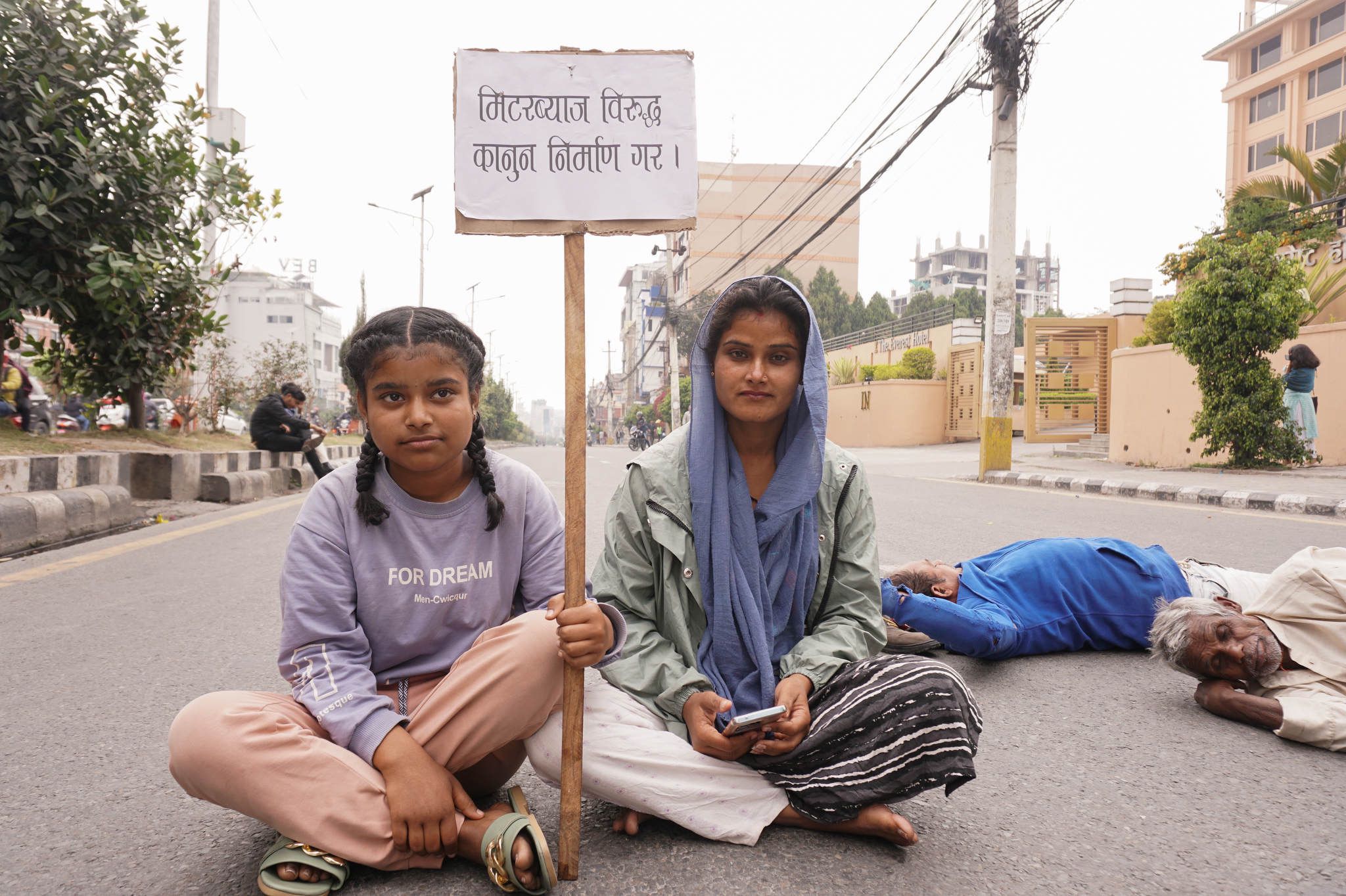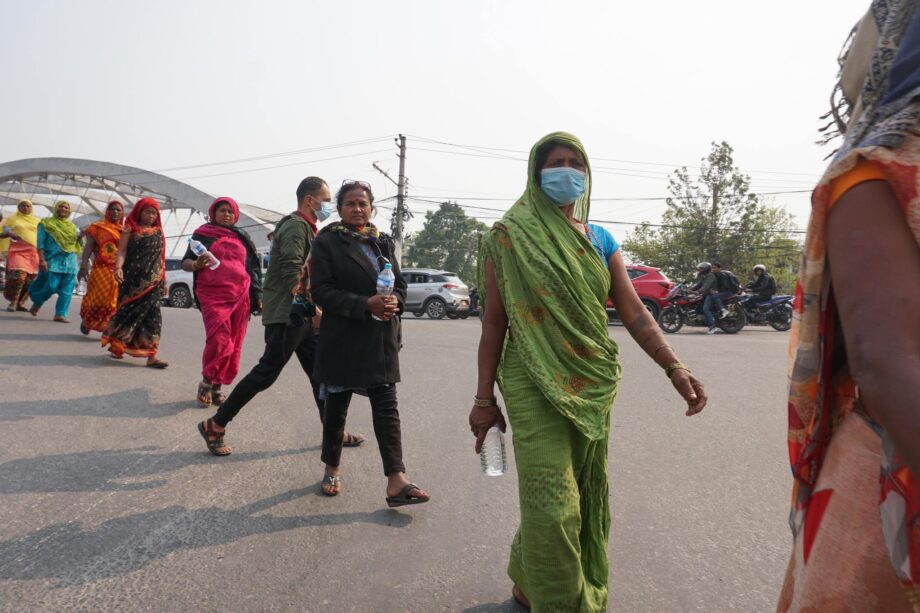
Sunita Neupane, GPJ Nepal
Garima Raye, left, holds a placard, which translated from Nepali reads “Enact the law against meterbyaj,” at a sit-in with her mother, Mamata Devi Raye, in the Baneshwor area of the capital city, Kathmandu.
KATHMANDU, NEPAL — She was someone Mamata Devi Raye thought she could trust. So, when Mamata was desperately in need of money for the treatment of her ill son four years ago, the 30-year-old turned to this “acquaintance” who happily agreed to help. Mamata put her thumb impression on a bunch of papers and immediately took 200,000 Nepali rupees (over 1,520 United States dollars).
She didn’t ask for a receipt, and the acquaintance didn’t give one — a common practice in such informal monetary exchanges in the Terai region of the southern lowlands of Nepal. Since it was an emergency loan, it was understood that Mamata would have to pay interest. But how much? Mamata didn’t know. Every week for about two months, Mamata paid 7,500 rupees (about 57 dollars) in interest. Yet despite paying continuously, her debt “never got paid off,” she says.
Eight months later, the acquaintance called on Mamata at her home in the region’s Siraha district and told her that in addition to the regular interest payments, she was to now pay an additional interest amount, along with the principal, which would make a one-time total payment of 1.6 million rupees (over 12,000 dollars). Mamata was sure that it was impossible for her to pay this huge amount. To “help” her, the acquaintance suggested an alternative. She could put up her land as collateral. Mamata agreed, thinking it couldn’t get any worse than this. Within days, without informing Mamata, the acquaintance sold off her land.
For decades, this has been the plight of many farmers like Mamata, who have only recently decided to collectively say no to this exploitation by loan sharks across Nepal.
Many farmers in rural areas, being unable to access credit from financial institutions for reasons such as illiteracy, have turned to unlicensed money lenders who then extort money in compound interests calculated in a system known locally as meterbyaj – so called because the rate of interest increases as fast as the numbers on a water meter. Eventually in such transactions, the meterbyaji, or loan shark, ends up seizing all land or property owned by the borrower.
When Mamata heard of villagers organizing a protest, she walked around 250 kilometers (155 miles) from the Mahottari district to the capital city of Kathmandu, accompanied by her 13-year-old daughter. “If we don’t get justice, we might as well die. But we are no longer willing to suffer the threats from the lenders. Does the government exist only during election for us to vote?” says Mamata.


Farmers like Mamata have come out on the streets of Kathmandu to demand justice. They have called on government leaders to introduce a new law on a fast track that would make meterbyaj an offense; to thoroughly investigate all the property of these loan sharks; and, going forward, to ensure fair financial transactions.
After months of protests, on May 3 the Nepal government introduced an ordinance to criminalize meterbyaj. Among other things, lenders who violate the law could be imprisoned for up to seven years and fined.
Late last year, the government formed a meterbyaj task force, which in its recommendation declared meterbyaj a financial crime. According to government figures handed over by Joint Secretary Bhishma Kumar Bhusal, from mid-August 2022 to February 2023, 3,226 complaints were lodged against loan sharks all over Nepal. But a committee of farmers protesting meterbyaj and fraud, estimates more than 400,000 people have had run-ins with meterbyaj.
Over months now, the crowds of protesters filling the streets have thinned out. One of the groups ended their protest after the government established an investigative commission and signed a five-point agreement with them on April 1. Among other things, the government agreed to make legal reforms to criminalize usury by the meterbyajis and to ensure that chief district officials are authorized to look into reports of such cases at the district level. Still, some farmers continue to protest, saying the agreement is insufficient.
So far, 12 farmers protesting in Kathmandu have been injured in police action, and 35 people have been arrested, says Awadhesh Kushwaha, president of the protesting farmers committee. Mamata says although she is still afraid of the meterbyaji, like many others today she is panicking because arrest warrants have been issued against some farmers for alleged fraud. She is worried “because the government is not taking any immediate action.”



Bhojraj Khatiwoda, chief officer for Siraha district, says meterbyaj “is not a problem that can be solved by magic. Discussions are going on with farmers and meter traders.”
Meterbyaj is prevalent in all 77 districts of Nepal but is mostly concentrated among the illiterate and poor in the Terai districts. The trap starts when the meterbyaji makes the borrower sign a tamasuk, or promissory note, in which the stated loan amount is three to 10 times the money that is actually borrowed, and the interest is somewhere between 36% and 60%, says Kushwaha. When the borrower is unable to meet the terms, Kushwaha says they can be faced with threats and physical harm, and the deeds they offer as collateral are quickly transferred to the loan shark’s own name — leaving many already financially vulnerable people in the region landless.
In the villages, taking loans from informal lenders is almost like an old tradition, Mamata says. Mamata took a loan. Mamata’s father took one. So did Mamata’s father’s father. In fact, a 2018 survey by The Asia Foundation, an international nonprofit, showed that most people in Nepal took a loan from an individual lender. Of these, 38.8% had a monthly income of less than 2,500 rupees (19 dollars) and 37.2% were illiterate.
Not all informal financial exchanges constitute meterbyaj. Bhusal, from the Nepal government, who is also the coordinator of the meterbyaj task force, says, “To write more than the borrowed amount, to seek higher than the legally determined interest rate, and to use intimidation and violence to recoup the loan constitutes meterbyaj.”
But since even these lenders have promissory notes signed or fingerprinted by the debtors, when there is a complaint, the borrower tends to appear to be the one at fault, Bhusal says.
Ideally, a person would go to a bank to seek a loan. But getting access to credit in a bank here is not easy, particularly if the borrower is illiterate or does not have property that the banks can trust for mortgage, says Manoj Gyawali, deputy CEO of Nabil Bank. “Documentation is required to take loans from the banks. To disregard this, people go to the meter interest people. The sharks give money within half-hour, and other than the land papers do not ask for any documentation from the farmers,” Gyawali says. He insists that there is no relation between banks and meterbyaj anywhere.



Despite being aware of the dangers of the meterbyaj system, there are many reasons why people fall into these debt traps. Deependra Bahadur Kshetry, former governor of the central bank, says banks have spread to many geographic locations; but for the loan needs of those at the bottom of the social hierarchy, in situations such as marriages, raising medical expenses or educating children, there are no provisions.
Sanjeev Uprety is an activist with Brihat Nagarik Andolan, a popular movement that has called for greater government accountability. The retired professor says the problem is still there because “meterbyajis are leaders of a local political party. They are the ones who fund the elections.”
However, Ministry of Home Affairs spokesperson Jitendra Basnet says, “Even though there have been such accusations, no evidence has been collected to prove them. The fact-finding commission will do case studies of both sides. If it’s found that they are funding the election, action will be taken.”
Dil Kumar Tamang, a ministry information officer who was a member of the committee that negotiated the April agreement with the protesters, says the government gave the commission a deadline of three months to submit its report.
But says Uprety: “By the time the commission prepares its report, thousands of farmers will have become landless.”
Mamata has no land now. But after losing everything, what makes her sad is the thought of her children’s future. Her 13-year-old daughter, who has not gone to school for several months now because of their fear of the meterbyaji, was in the top of her class before her mother fell into the debt trap.



Sunita Neupane is a Global Press Journal reporter based in Nepal.
TRANSLATION NOTE
Sandesh Ghimire, GPJ, translated this article from Nepali.







